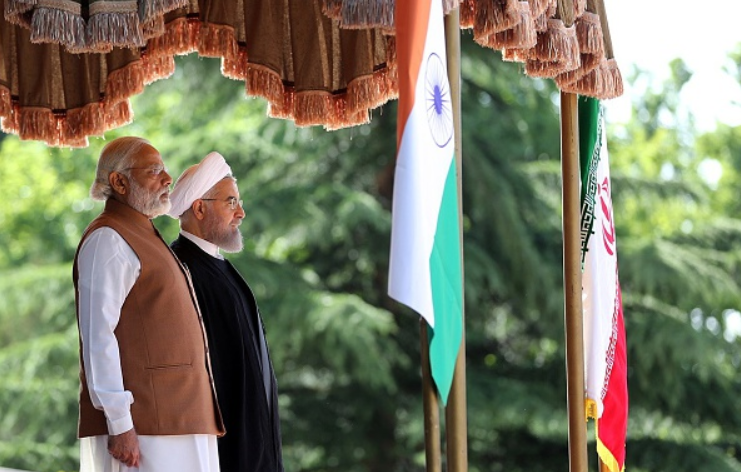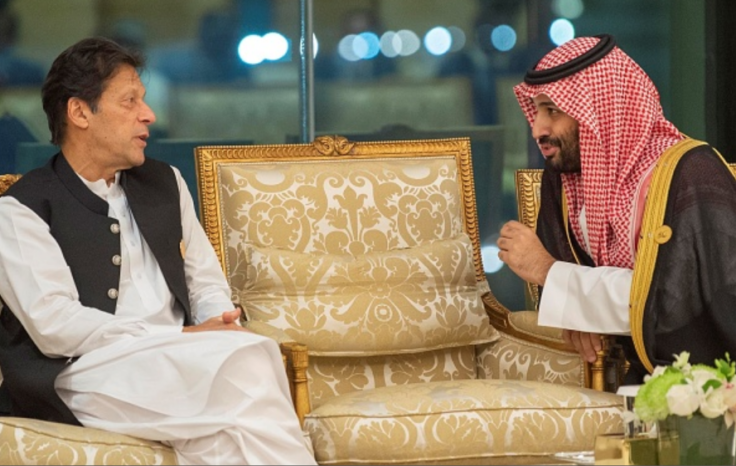
A few months into President Biden’s presidential term, reports emerged that Saudi Arabia and Iran, traditional adversaries, were now sitting across the table in Baghdad negotiating improvement in ties. A few days later, Saudi Arabia’s de facto ruler, Crown Prince Mohammed Bin Salman, surprised the world by declaring, “We aspire for a good and special relationship with Iran.” Tehran, which had terminated diplomatic relations with Riyadh in January 2016, responded favorably by willing to “enter a new phase of cooperation and tolerance.” Experts attribute this sudden turn of the events to Washington’s signaling of a hands-off approach towards the Middle East. As Trita Parsi of the Quincy Institute notes, “Washington’s turn away from entangling itself in the quarrels and stratagems of its Middle Eastern partners has compelled the region’s powers to explore their own diplomacy.”
In the previous two U.S. administrations, the incoming president has sought to redefine relations with the Middle East – Obama’s rapprochement with Iran through the Joint Comprehensive Plan of Action (JCPOA) and Trump’s “maximum pressure” strategy towards Iran coupled with cordiality with Saudi Arabia. Biden’s early signals of unassertiveness — to the extent that he backtracked on campaign promises to be tough on Saudi Arabia and has not successfully negotiated the Iran deal yet despite upcoming Iranian presidential elections—demonstrates a range of fluid and irreconcilable Middle East policies Washington has pursued. These policy shifts alter the dynamics between two major Middle East powers—Saudi Arabia and Iran. With multi-stranded Middle East ties ranging from immigration to energy, India and Pakistan must attune to these changing Saudi-Iran dynamics too. In doing so, India and Pakistan’s foreign policy orientation, demography, and material interests either facilitate or constrain their ability and pace to reorient their ties with Saudi Arabia and Iran. With the new Saudi-Iran thaw, India is likely to take advantage of the situation to serve its economic and political interests. Pakistan, on the other hand, views Iran and Saudi Arabia as two members of the larger Muslim community and is expected to continue its futile efforts to unite the Muslim Ummah, instead of reorienting its largely ideological priorities to geoeconomics.
Foreign policy orientation
With a stated foreign policy objective in the constitution to “preserve and strengthen fraternal relations among Muslim countries based on Islamic unity,” Pakistan’s Middle East policy’s ideological foundation seems to be an extension of its Islamic nationalism. However, in the early years of the Cold War, Pakistan’s alliance with the United States had a strong influence on its ties with both Iran and Saudi Arabia. Unlike Pakistan, India’s initial approach to these countries was through the Non-Aligned Movement (NAM) and Afro-Asian solidarity. Egypt, Iran, the UAE, Iraq, Jordan, Bahrain, and other Middle Eastern countries have remained active members of NAM at various points. However, with the formation of the Organization of Islamic Cooperation (OIC), and Pakistan’s successes in advancing the Kashmir cause in the OICs during the 1970s, both countries’ Middle East policies hardened on religious lines. While Pakistan’s imagination of pan-Islamism was emboldened by its success at the OIC, India’s non-alignment enthusiasm dampened giving space to disappointment and disengagement as New Delhi too started to conceive the region as an Islamic bloc. Any hopes for successful relations subsided when most Middle Eastern countries, including Iran and Saudi Arabia, supported Pakistan in the 1971 India-Pakistan conflict.
With the new Saudi-Iran thaw, India is likely to take advantage of the situation to serve its economic and political interests. Pakistan, on the other hand, views Iran and Saudi Arabia as two members of the larger Muslim community and is expected to continue its futile efforts to unite the Muslim Ummah.
The region started to fall off New Delhi’s political radar despite bourgeoning commercial ties, increasing people-to-people contact, and steady hydrocarbon partnership. With the advent of the Modi administration, New Delhi altered India’s Middle East policy, unshackling it from the dated religious understanding and acquiring a geopolitical outlook based on engagement with countries and blocs on issues of political and strategic interests. This allowed New Delhi to gauge its relations with Riyadh and Tehran individually from time to time, albeit remaining cognizant of its ties with the United States. Hence, when the Trump administration’s pressure grew, New Delhi scaled back the development of Chabahar port in Iran but revved it up once the Biden administration signaled a thaw in U.S.-Iran relations.
On the other hand, Pakistan’s continued political successes with the OIC–for instance, the formation of the “Contact Group” in 1994–stagnated its foreign policy orientation. Despite notable shifts in global ideological trends since and the failure of pan-Islamism, Pakistan stayed the course of its Islamic discourse. It chose ideological policy objectives, with an imaginative leadership role as the only nuclear Islamic state, despite its diminishing economic heft. Despite growing tensions between Tehran and Washington and Riyadh after the 1979 Iranian revolution, Pakistan avoided taking sides, viewing Iran as a Shia Muslim “brother” state. Recently, Pakistan’s Islamic diplomatic orientation has received several reality checks. Pakistan could not effectively mobilize the OIC after India abrogated Jammu and Kashmir’s special status in August 2019. Furthermore, bordering Islamic states, Iran and Afghanistan, accuse it of sponsoring terrorism on their soil. Despite such setbacks, policy circles in Islamabad hail the Saudi-Iran balancing act as a promotion of peaceful relationships among members of the Ummah, instead of separately weighing geoeconomic and geopolitical implications of ties with both countries. Given this theoretical “unity among Muslims” worldview of Islamabad, it is unable to embrace the fault lines within the so-called Islamic world—be it between Riyadh and Tehran, Riyadh and Ankara, or Riyadh and Doha.
Demography and Dependence
Even if both countries wish to reorient their foreign policy objectives, two fundamentals constrain such shifts to various degrees—demography at home and economic dependence on both Saudi Arabia and Iran. Contributing to Pakistan’s inability to choose sides in the Saudi-Iran conflict is the presence of politically active pro-Iran Shia groups in the country that use supporters and sympathizers in mainstream political parties and state institutions to counter any Islamabad-Riyadh partnership that conflicts with Iranian interests. Hence, while Pakistan’s neutrality in Yemen and Qatar angered its Arab friends, it chose to keep its support for the Saudi coalition only implicit, considering the opposition of Shia groups at home and its 800 kilometers long unprotected and sensitive border with Iran.

Compared to Pakistan, New Delhi neither shares the former’s border conflicts nor internal oppositional challenges. Even though Muslims constitute 15 percent of the total Indian population, their political representation has plateaued at around five percent. Moreover, most regional parties that secure nearly half of the popular vote do not exert influence on foreign policy, leaving it to two national parties—the BJP or the Congress. In general, Shias have been supportive of India’s ruling Bharatiya Janta Party’s (BJP) domestic and foreign policies, including controversial ones such as the Ram temple dispute and the abrogation of Article 370. Some of these Shia religious groups have taken to the streets in small numbers to protest India’s unfavorable positions towards Tehran or the visit from the American president. Nonetheless, these are highly localized events and, thus, do not impact the government’s Iran and Saudi Arabia policies.
Both countries are also concerned with their respective economic interests. As economic stability is a major governance challenge for Pakistan, it cannot afford to muddle its ties with Saudi Arabia, given that investment, loans, and remittances from Saudi Arabia significantly contribute to Pakistan’s economy. Last year, reacting to the Foreign Minister of Pakistan Shah Mahmood Qureshi’s criticism of Saudi-led OIC for not supporting Pakistan’s stance on Kashmir, Saudi Arabia rescinded its offer of a USD $3 billion loan, and did not renew the USD $3.2 billion oil credit to Pakistan. Pakistan, realizing the economic cost, immediately took measures to mend the strained ties, sending its Chief of Army Staff to Riyadh. While Pakistan also seeks to bolster its economic relationship with Iran, it has adopted a cautious approach to avoid infuriating both Washington and Riyadh. With easing tensions between Iran and Saudi Arabia, Islamabad has recently taken important steps for improving economic ties with Tehran, such as establishing border markets. However, key economic projects, such as the Iran-Pakistan Oil Pipeline, remain stalled.
The Biden administration’s approach, at least for now, affords Pakistan and India flexibility in calibrating ties with Saudi Arabia and Iran.
Not able to independently balance Saudi-Iran dynamics proves costly for India as well. Before President Trump’s “maximum strategy” towards Tehran that forced allies like India to cut off all sorts of economic ties, Iran was India’s second-largest source of crude oil, offering additional benefits such as payment in Indian rupees, free freight, and shipping insurance. However, India gave up on this lucrative deal that impacted its domestic fuel prices and inflation rates, causing domestic unrest and unpopularity and denting the country’s foreign exchange reserves. Alternatively, India refrained from entirely scaling back on its port development effort in Chabahar as that would have been a massive blow to India’s long-term geopolitical strategy. Nonetheless, India’s economic challenges are not as critical as Islamabad’s, whose economy is subsisting on an IMF bailout.
Conclusion
The shadow of Washington looms large over Islamabad and New Delhi when drafting policies on Iran and Saudi Arabia, while other individual factors also constrain or facilitate their decision-making. The Biden administration’s approach, at least for now, affords Pakistan and India flexibility in calibrating ties with Saudi Arabia and Iran. The Iranian and Saudi leadership’s rapprochement efforts bring positive tidings for South Asian countries that could benefit from improved trade relations. However, while India, with inconsequential domestic pressure and a geopolitical outlook, is likely to view the current development in light of its economic and geopolitical interests, Pakistan is expected to view interactions with the region through a religiopolitical framework, despite recent events proving the futility of ideological partnerships.
***
Click here to read this article in Urdu.


